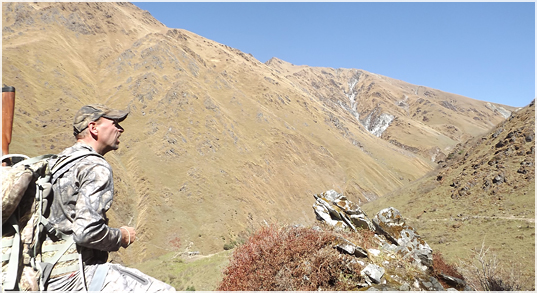About Himalayan Bluesheep
Himalayan Bluesheep, known as Naur in Nepali in Nepal and Bharal in Hindi in India. Himalayan Bluesheep is a high mountain sheep which survives from 3500 meter to 6000 meter. Bluesheep have short and dense hair. Distinctive physical features are labeled on the pictures below. Females can be half to two-thirds the size of males. Young Bluesheep are smaller and browner. Himalayan Bluesheep are preferred prey for snow leopards.
General Characteristics:
The short, dense coat is slate grey in colour, sometimes with a bluish sheen. The underparts and backs of the legs are white, white the chest and fronts of the legs are black. Seperating the grey back and white belly is a charcoal coloured stripe. The ears are small, and the bridge of the nose is dark. The horns are founded in both sexes, and are ridges on the upper surface. In Males, they grow upwards, then turn sideways and curve backwards, looking somewhat like an upside-down moustache. They may grow to length of 80 cm/ 32 in. In females, the horns are much shorter and straighter, growing up to 20 cm/ 8 inches long.
Ontogeny and Reproduction:
Gestation Period: 160 Days
Young per Birth: 1
Weaning: After 6 months.
Sexual Maturity: At 1.5 years, although males do not reach their full potential befor age 7.

Ecology and Behavior:
Himalayan Bluesheep are active throughout the day, alternating between feeding and resting on the frassy mountain slopes. Due to their excellent camouflage and the absence of cover in their environment, Bluesheep remain motionless when approached. Once they have been noticed, however, they scamper up to the precipitous cliffs, where they once again freeze, "melting" into the rock face.
Rutting Behaviour:
The rutting of the Himalayan Bluesheep starts in towards late November and continues until mid- January. During the rut male Bluesheep use multiple strategies for mating as like tending, blocking and coursing. The young are born in late June and July.
Diet:
Himalayan Bluesheep are herbivores, eating grasses, leaves, mosses and lichens.Habitat:
Himalayan Bluesheep live at elevation of 4,000 meter( 13100 ft) to 6,000 meter ( 19600 ft). They prefer bare, rocky hills above the tree line but below the snow line, where grass is abundant.
Our Hunting Packages
Bluesheep Hunting

Nepal is real highland place in the world. Bluesheep is main hunting species of Nepal Hunting. Bluesheep hunting is challenging, breathtaking and un-paralled sport trophy hunting...
View Detais
Himalayan Tahr Hunting

Himalayan Tahr Hunting in Nepal is neturally tahr hunting in the world. You can have tahr hunting in New Zealand and England too but these are not neturally as like Nepal which was taken from Nepal...
View Detais
Combo Hunt

Nepal is one of the best higland real adventure hunting place in the world. Nepal known as challenging, breathtaking and un-paralleled hunting place in the world. These three words describe about Bluesheep & Himalayan Tahr...
View Detais





















